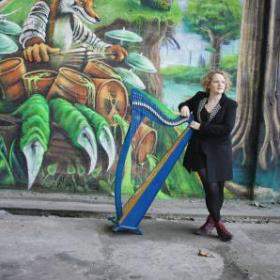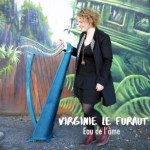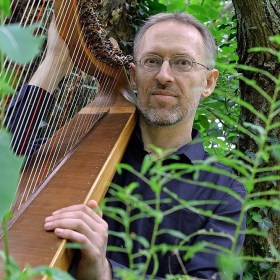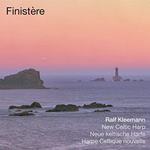A Harp Ireland initiative, Saturday the 20th October was National Harp Day (Lá na Cruite), and concerts, performances and harp encounters were happening not only all around Ireland, but in Europe and as far afield as the USA - all in celebration of the harp!
The Celtic harp is a triangular harp traditional to Wales, Brittany, Ireland and Scotland. It is known as telyn in Welsh, telenn in Breton, cláirseach in Irish and clàrsach in Scottish Gaelic. In Ireland and Scotland, it was a wire-strung instrument requiring great skill and long practice to play, and was associated with the Gaelic ruling class. It appears on Irish and British coins and coat of arms of the Republic of Ireland, the United Kingdom and Canada.
The early history of the triangular frame harp in Europe is contested. The first instrument associated with the harping tradition in the Gaelic world was known as a cruit. This word may originally have described a different stringed instrument, being etymologically related to the Welsh crwth. It has been suggested that the word clàrsach / cláirseach (from clàr / clár, a board) was coined for the triangular frame harp which replaced the cruit, and that this coining was of Scottish origin.
Three of the four oldest authentic harps to survive are of Gaelic provenance: the Trinity College Harp preserved in Trinity College Dublin, and the Queen Mary Harp and the Lamont Harp in the National Museum of Scotland, Edinburgh. The last two are examples of the small low-headed harp, and are both made from hornbeam, a wood not native to Scotland or Ireland. All three are dated approximately to the 15th century and may have been made in Argyll in western Scotland. Many “Irish” harps from later periods have no provenance and could possibly be of Scottish origin.
The Norman-Welsh cleric and scholar Gerald of Wales (c.1146 – c.1223), whose Topographica Hibernica et Expugnatio Hibernica is a description of Ireland from the Anglo-Norman point of view, praised Irish harp music (if little else), but added that, in the opinion of many, the Scots had now surpassed them in that skill. Gerald refers to the cythara and the tympanum, but their identification with the harp is uncertain, and it is not known that he ever visited Scotland.
Scotland, because of her affinity and intercourse [with Ireland], tries to imitate Ireland in music and strives in emulation. Ireland uses and delights in two instruments only, the harp namely, and the tympanum. Scotland uses three, the harp, the tympanum, and the crowd. In the opinion, however, of many, Scotland has by now not only caught up on Ireland, her instructor, but already far outdistances her and excels her in musical skill. Therefore, [Irish] people now look to that country as the fountain of the art.
Early images of the clàrsach are not common in Scottish iconography, but a gravestone at Kiells, in Argyllshire, dating from about 1500, shows one with a typically large soundbox, decorated with Gaelic designs. The Irish Maedoc book shrine dates from the 11th century, and clearly shows a harper with a triangular framed harp including a "T-Section" in the pillar. The Irish word lamhchrann or Scottish Gaelic làmh-chrann came into use at an unknown date to indicate this pillar which would have supplied the bracing to withstand the tension of a wire-strung harp.
Three pre-16th-century examples survive today; the Brian Boru Harp in Trinity College, Dublin, and the Queen Mary and Lamont Harps, both in Scotland.
One of the largest and most complete collections of 17th-18th century harp music is the work of Turlough O'Carolan, a blind, itinerant Irish harper and composer. At least 220 of his compositions survive to this day.


In construction the Irish and Scottish harps may in general be considered as one. A characteristic feature is the metal strings. Historical sources mention various types of wire, including brass and iron; some scholars also argue for the use of silver and gold. The wires were attached to a massive soundbox typically carved from a single log, commonly of willow, although other woods including alder and poplar have been identified in extant harps. This harp also had a reinforced curved pillar and a substantial neck, flanked with thick brass cheek bands. The strings, usually played with the fingernails, produced a brilliant ringing sound. This type of harp is also unique amongst single row triangular harps in that the first two strings tuned in the middle of the gamut were set to the same pitch.
In Scottish Gaelic, the names of the components of the clàrsach were as follows: amhach (neck), cnagan (pins), corr (pin-board), com (chest or soundbox), làmh-chrann (tree or forepillar), teudan (strings), cruidhean nan teud (string shoes), urshnaim (toggle?).
The corr had a brass strap nailed to each side, pierced by tapered brass tuning pins. The treble end had a tenon which fitted into the top of the com (soundbox). On a low-headed harp the corr was morticed at the bass end to receive a tenon on the làmh-chrann; on a high-headed harp this tenon fitted into a mortice on the back of the làmh-chrann.
The com (soundbox) was usually carved from a single piece of willow, hollowed out from behind. A panel of harder timber was carefully inserted to close the back.
Cruidhean nan teud (string shoes) were usually made of brass and prevented the metal strings from cutting into the wood of the soundbox.
The urshnaim may refer to the wooden toggle to which a string was fastened once it had emerged from its hole in the soundboard.


The playing of the wire-strung harp has been described as extremely difficult. Because of the long-lasting resonance, the performer had to dampen strings which had just been played while new strings were being plucked, and this while playing rapidly. Contrary to conventional modern practice, the left hand played the treble and the right the bass. It was said that a player should begin to learn the harp no later than the age of seven. The best modern players have shown, however, that reasonable competence may be achieved even at a later age.
During the medieval period the wire-strung harp was in demand throughout the Gaelic territories, which stretched from the northern Highlands and Western Isles of Scotland to the south of Ireland. The Gaelic worlds of Scotland and Ireland, however, while retaining close links, were already showing signs of divergence in the sixteenth century in language, music and social structure.
The function of the clàrsach in a Hebridean lordship, both as entertainment and as literary metaphor, is illustrated in the songs of Màiri Nic Leòid (Mary MacLeod) (c.1615 - c.1705), a prominent Gaelic poet of her time. The chief is praised as one who is skilled in judging harp-playing, the theme of a story and the pith of sense:
The music of harp and pipe is shown to be intrinsic to the splendour of the MacLeod court, along with wine in shining cups:
Here the great Highland bagpipe shares the high status of the clàrsach. It would help supplant the harp, and may already have developed its own classical tradition in the form of the elaborate “great music” (ceòl mòr). An elegy to Sir Donald MacDonald of Clanranald, attributed to his widow in 1618, contains a very early reference to the bagpipe in a lairdly setting:
There is evidence that the musical tradition of the clàrsach may have influenced the use and repertoire of the bagpipe. The oral mnemonic system called canntaireachd, used for encoding and teaching ceòl mòr, is first mentioned in the 1226 obituary of a clàrsair (harp player). Terms relating to theme and variation on the clàrsach and the bagpipe correlate to each other. Founders of bagpipe dynasties are also noted as clársach players.
The names of a number of the last harpers are recorded. The blind Duncan McIndeor, who died in 1694, was harper to Campbell of Auchinbreck, but also frequented Edinburgh. A receipt for “two bolls of meall”, dated 1683, is extant for another harper, also blind, named Patrick McErnace, who apparently played for Lord Neill Campbell. The harper Manus McShire is mentioned in an account book covering the period 1688 to 1704. A harper called Neill Baine is mentioned in a letter dated 1702 from a servitor of Allan MacDonald of Clanranald. Angus McDonald, harper, received payment on the instructions of Menzies of Culdares on 19 June 1713, and the Marquis of Huntly’s accounts record a payment to two harpers in 1714. Other harpers include Rory Dall Morison (who died c.1714), Lachlan Dall (who died c.1721–27) and Murdoch MacDonald (who died c.1740).
By the middle of the eighteenth century the “violer” (fiddle player) had replaced the harper, a consequence, perhaps, of the growing influence in the Gaelic world of Lowland Scots culture.
In the early 19th century, even as the old Gaelic harp tradition was dying out, a new harp was invented in Ireland. It had gut strings and semitone mechanisms like an orchestral pedal harp, and was invented by Dublin pedal harp maker John Egan. It was small and curved like the historical cláirseach or Irish harp, but its strings were of gut and the soundbox was much lighter. In the 1890s a similar new harp was also developed in Scotland as part of a Gaelic cultural revival.
There is now, however, renewed interest in the wire-strung harp, or clàrsach, with replicas being made and research being conducted into ancient playing techniques and terminology.

Text is available under the Creative Commons Attribution-ShareAlike License.
Date: October 2018.
Photo Credits:
(1) National Harp Day (Lá na Cruite),
(2) Sharon Carroll,
(3) Verginie Le Furaut,
(4) Ralf Kleemann
(unknown/website).